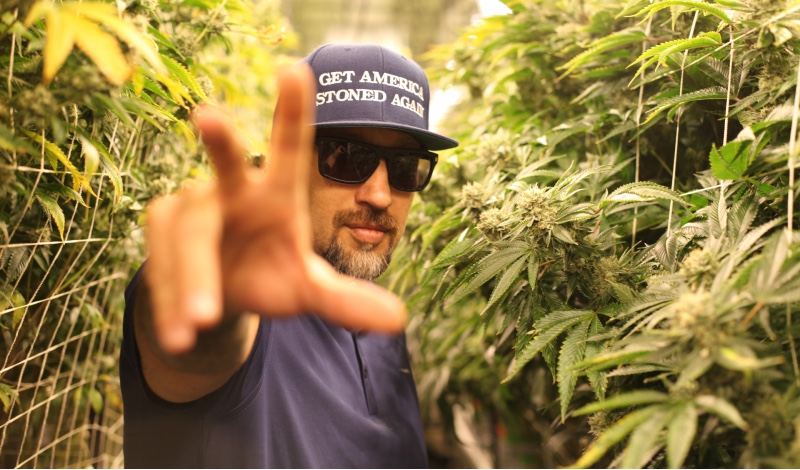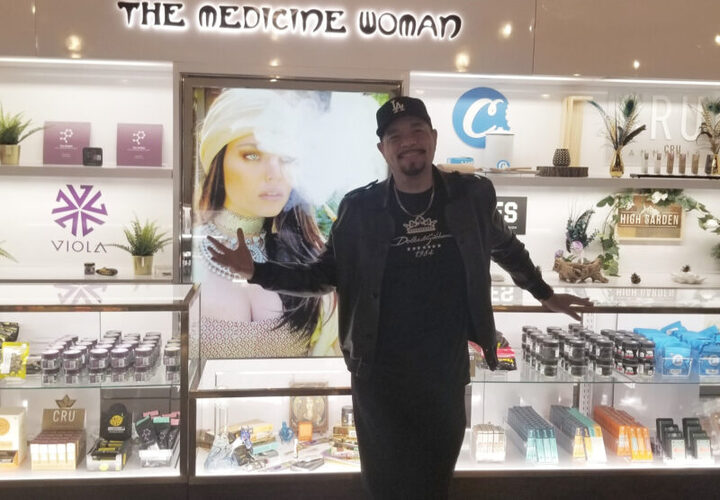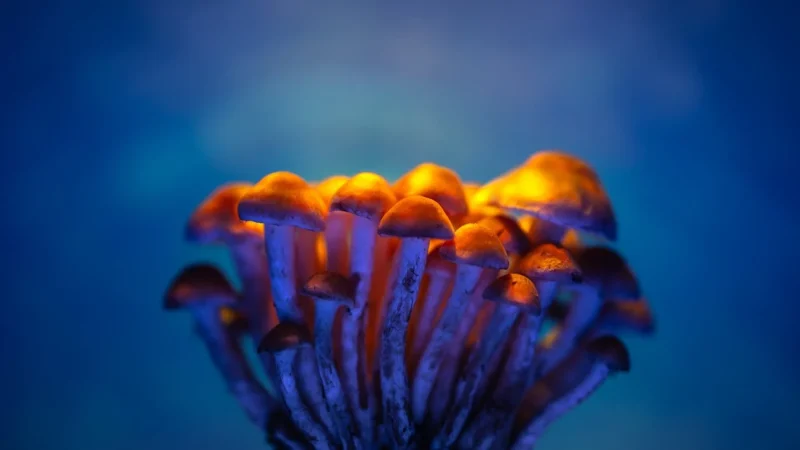For cannabis enthusiasts of a certain age, Cypress Hill was the soundtrack to countless smoke sessions.
As the band members have matured their interest in cannabis has evolved as well.
Lead singer B-Real’s latest project with master grower Kenji Fujishima is THC Controls, a cultivation automation system that allows growers to take a hands-off approach to farming.
Cannabis & Tech Today’s Sara Brittany Somerset interviewed B-Real for the spring 2021 issue and learned so much that we couldn’t fit it all into print. Read on for the full story.
Cannabis & Tech Today: Have any of the larger, corporate cannabis Multi-State Operators (MSOs) such as Tilray, Canopy Growth, or Aphria approached you yet, to acquire THC Controls?
B-Real: Not that I’m aware of yet, but I would imagine that at some point they will come calling.
We haven’t gone out of our way to pitch our system to any other brands.
I mean, it’s just a matter of time before people get into the cannabis industry.
It’s a lot about word-of-mouth when people find something new to use, whether it’s a nutrient, new technology, or even a new strain or genetic.
I believe once the word starts getting around about the control systems we offer, and how people have been able to utilize it, be successful with it and get what they need out of it, I believe that companies will be knocking on the door for the THC Controls.
C&T Today: Your legendary cultivation expertise is what gives you a leg up over other MSOs who are newer to the game. Are you not concerned about arming the competition with your proprietary tech?
B-Real: Realistically, for us, we don’t necessarily worry about the competition in that way.
We’re very secure and confident in what we do that we could share this type of technology out and still do well.
Because it’s about the genetics that you have that are unique to the market, and how you cultivate and go about using them.
It doesn’t mean that they’re tied into our SOPs.
Everyone will have their own SOPs and they can record them and do the research on their data that they come up with, or we could share them our SOP. It just depends.
C&T Today: Quality control is a serious issue among MSOs. How will THC Controls align the inconsistency factor?
B-Real: If you’re an MSO, you have to put strains in all these different markets.
It helps you keep consistent with where the strain started.
So, if it’s a California strain and these are the SOP we use, we can make sure that the operators that are cultivating our genetics in that state can be consistent and adhere to our SOPs.
And we can feed, monitor, and supervise them to make sure that they’re staying on those. I think it’s important for any company, especially relating to genetics, to keep consistent.
Too many times you see the brands that do genetic deals in an MSO situation where you go to a particular city or state, and that product is nothing like it is in its original territory.
This will give you feedback, so, if you are an MSO and you’re trying to keep that consistency in your product, as it relates to the flower, this system will provide better tools to handle that issue.
C&T Today: Quality control across different markets has always been an issue due to varying parameters. There hasn’t been a fool-proof way to standardize it. Until the advent of federal legalization, which will hopefully legalize interstate commerce, a brand-name herb in California might not taste, or be the same quality that you get in Colorado. Therefore, having an underlying factor that will equalize variants will be very helpful to cultivators.
B-Real: Exactly! THC Controls can definitely help with that.
C&T Today: In your opinion as an OG grower, what are the most important factors for quality cultivation?
Kenji Fujishima: I think with any cultivation, whether it’s hydro or indoor or outdoor or greenhouse, it’s how you care for the plants.
First of all, it’s the environment. You got to have the right environment.
With that being said, it’s the care of the plants. What you’re feeding the plants and how well and dedicated you are to that plant.
Are you cleaning the plant? You’re making sure pests aren’t there, and if they are how do you take care of them?
It’s the practices and the methodologies in which people take care of their plants.
I mean, some people just want to plant it and forget it because they don’t know, and some people are just lazy growers.
Some people love the plant and, at the end of the day, that’s the kind of product you see what those people did during that growth cycle. You’ll see the love in the flower.
Nowadays, there’s care for the plants, but also at scale it’s not like you can talk to each plant because some facilities have thousands of plants, if not tens of thousands of plants.
With that being said, is where the control systems have come in where now people, rather than hand watering.
I was always a firm believer in hand watering. It wasn’t necessarily just because I didn’t understand automated feeding, but what it did was make me pay attention to every plant.
That was always what I was telling people who were learning from me at the time, is pay close attention to the plants. If you walk into a room you need to not only see, but you need to feel what’s going on.
And then, if there’s something wrong with the environment, you need to be able to make those adjustments. Full automation is great, but you should still pay attention to your plants.
If you walk into a room and you see the plants drooping or doing something weird, you need to be out there to identify that to see if there’s a problem.
Correct that problem before it might start spreading to other plants.
I think the automation stuff and what we’re doing now, and a few other companies are doing, is just it allows a lot of human error to be taken out of the factor of watering.
It’s also a time saver because now that you’re not having to worry about the watering cycle, the employees or the person that’s running the grow have more time to spend with the plants, which is I think the most important thing – care of the plants.
C&T Today: There are additional important factors for quality cultivation, including using clean water. Does THC incorporate that too?
Kenji Fujishima: If you talk about lots of water right now, that’s not changed, but it’s more carefully thought about. Back in the day, we would just water the plants until they fully were running off just to keep them saturated.
Now, with technology and the systems that we’re using, we’re figuring out what percentages of median saturation that the plant needs to run the best possible crop.
Just because it’s wet doesn’t mean it’s good. If it’s over wet that’s bad. If it’s too dry, that’s also bad.
There’s a percentage or a ratio of where the median should be wet. Again, this is going to be different for everybody out there, depending on their temperatures, their humidities, and whatnot.
How far they dry back, how far they saturate, to get the best results. What THC Controls does is measure those levels.
Water sensors will tell us the correct percentage saturation, and it’s going to dry to this percentage, so if we could find the perfect percentages on both ends, to figure out how to not only grow the best product but produce more. They call that crop steering.
It’s like you’re guiding your crop to the best possible outcome and you can only do that with data.
If you know, for example, THC Controls will not only record what your temperatures are, what your humidities are, what the light levels are, also the saturation level of your median.
Once you find that perfect combination of all those, that’s going to be the best possible scenario for making the best product.
C&T Today: Walk me through how this works. Let’s say a corporation raised a ton of investment money but has no idea what they’re doing and they want to subscribe to THC Controls or purchase a THC Controls encapsulated unit. What does that look like from point A to point B?
Kenji Fujishima: The guys from THC Controls will come to the facility and they’ll assess what you have as far as your operation, whether it be a greenhouse or if it’s an indoor facility. From there, it’s a preferential thing and a budget thing. What do you want it to control or what are your goals?
Because we can control watering, but we can also control everything else that goes along with it. Let’s just say, for example, you want to automate your whole facility.
They’re going to assess how many things need to be controlled so we can figure out how much equipment is going to be needed to do this because, whether you’re controlling one room or five rooms or whether you have one component in a room or 10 components, different size modules that have to be used.
Next, they put that together and they give you a program. Once the system is installed, it allows you to tune and run your grow room to your specifications based on, not only your formulas but what temperatures, what humidities you want. At one point in your growth cycle do you want these things to happen?
For example, if you have an eight-week strain you could program the system to run the complete eight weeks of your harvest. We’re talking about everything from what your humidity is in a room at a specific time or week.
Your humidity, your temperature, and then what you’re feeding it, and the duration of those feeds. It goes back to where we were talking about the saturation points of the medians. They used to hand water, but you want to water 30 seconds, 14 times a day, or something like that.
That’s what might be needed. Now you can do that.
C&T Today: Do you check in at specific intervals? Let’s say it’s four weeks in and my leaves are looking a little yellow on the lower limbs and they need some nitrogen. Is that something you monitor and alert?
Kenji Fujishima: Again, that comes into the plant care.
Just because it’s automated doesn’t mean that it controls everything because plants are living organisms, so sometimes shit happens.
Sometimes you have equipment failures.
Generally, if a plant’s sick it might not be eating as much, so you’re going to notice that. You still have to look at it.
We set multiple sensors throughout the rooms so that when you’re looking at it you could tell if there are hot spots in the room or if one area of the room is a little bit higher humidity or if the CO2 is higher in a certain area.
It lets you know that. You’re looking at a screen that’s telling you exactly what’s going on in your room at that time.
And then, there are also graphs that you can go back and see if there were spikes or something weird that was going on.
It’ll give you the time, so it allows you to adjust what you need to when you see a problem or if you see a problem.
C&T Today: Do you incorporate micronutrients into the system?
Kenji Fujishima: Yes, we do.
At first, this was used to control lighting, humidity, temperature, and all that kind of stuff.
Now, what we were noticing is also incorporating the actual feed program, because it’s easy to turn on an existing one.
If you hand mix a reservoir, it’s easy to have that pump turn on to feed it.
Now what we’re doing is we’re building our fertigation skids. Are you familiar with fertigation at all?
C&T Today: I am, but kindly enlighten our readers.
Kenji Fujishima: Fertigation is a method.
For example, some machines will take your concentrated nutrients and mix them in line through the tank and feed it to your plants.
You set this equipment up to automate the mixing of your nutrients, whether it be micronutrients or salts or whatever it is, these machines do it.
Typically, these systems — what you can buy, most of them are proprietary or older technology.
We weren’t able to get other companies to work with us so that we could integrate those machines with THC Controls.
What we have to do is build our own. We work with a company called Bear Ag and they’re building the machine for us.
They’re building the hardware part of it.
The injectors, the things that are going to take our concentrates and send them to a mixing tank.
They’re working with THC Controls to build the brain to talk to that system.
Now, what that allows us to do is that it allows the environment control system to talk to the feeding system so that it all works together.
Now, we’re talking about how we can control everything from the feeding end of it to the environment control part of it.
C&T Today: I assume the THC Controls cultivation system is primarily for indoor “hydro” grows because you cannot regulate outdoor conditions. Would the system work in an outdoor greenhouse?
B-Real: For outdoor I imagine it wouldn’t be that effective, but I don’t think we’ve run that sort of test yet. I believe the grow op has to be in an enclosed area.
I think that’s something that will eventually catch on in the future. The system is primarily used for Indoor grows and greenhouses.
Kenji Fujishima: As far as the feeding system is concerned, yeah. Anything that’s plugged into power we can control.
Header Image courtesy of Pedro Garcia.
Author
-

Sara Brittany Somerset is a United Nations & cannabis correspondent based out of UN HQ in New York, NY and Orange Hill, Jamaica.






